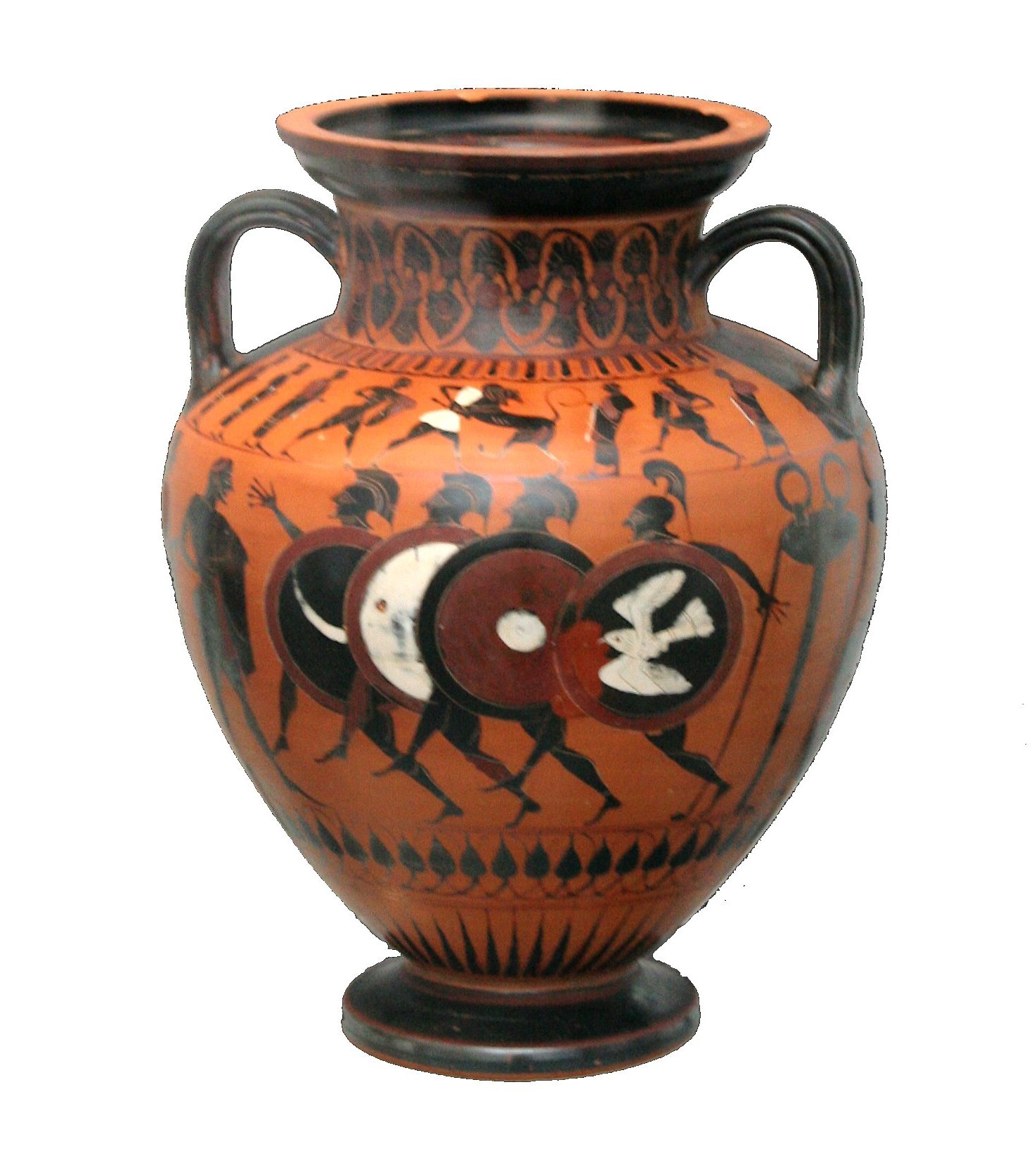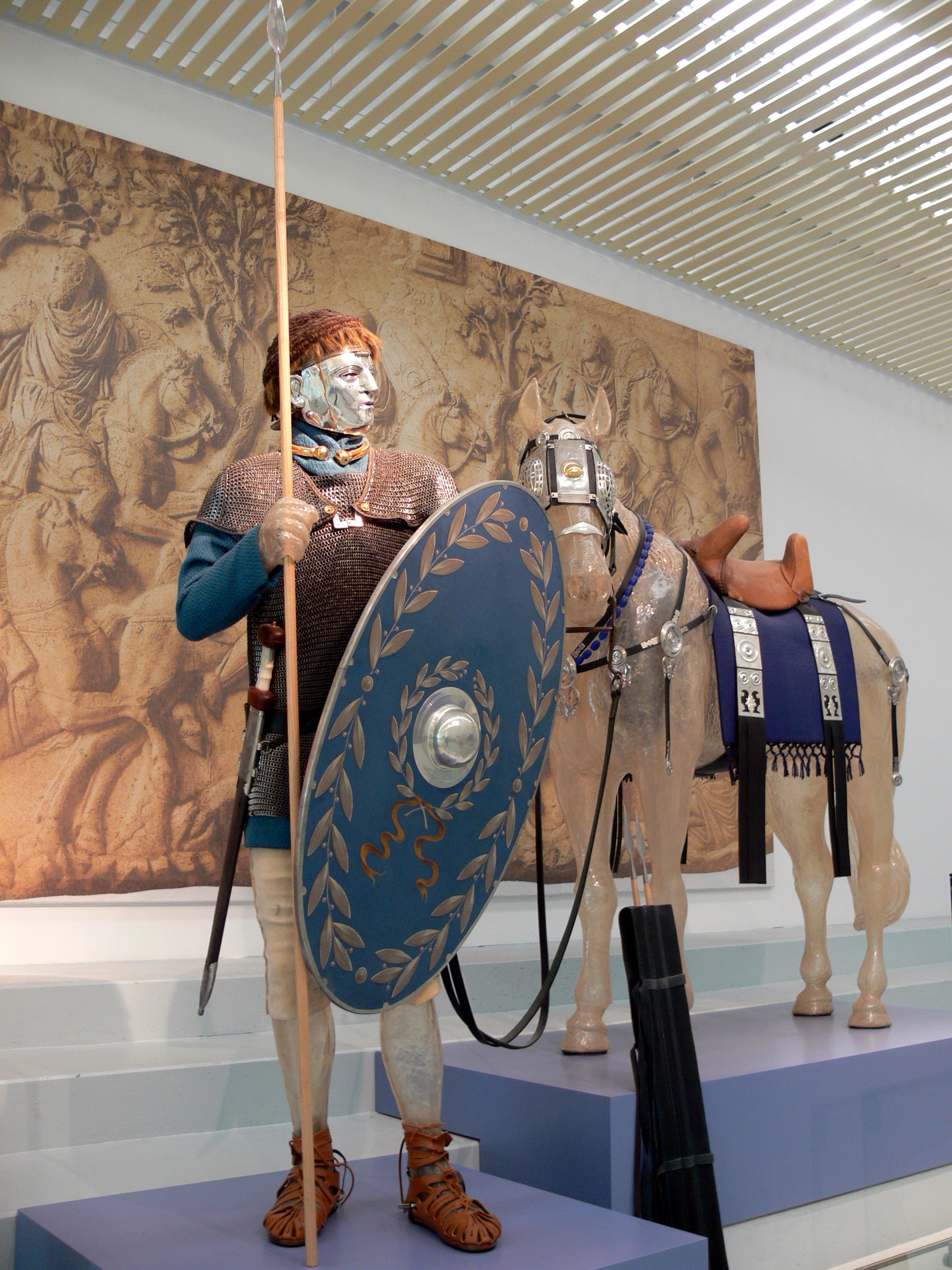|
Clipeus
In the military of classical antiquity, a ''clipeus'' (; Ancient Greek: Aspis, ἀσπίς) was a large shield worn by the Ancient Greece, Greek Hoplite, hoplites and Ancient Rome, Romans as a piece of defensive armor, which they carried upon the arm, to protect them from the blows of their enemies. It was round in shape and in the middle was a bolt of iron, or of some other metal, with a sharp point. The ''clipeus'' was more-or-less identical to the earlier ''aspis''. In art Pliny the Elder also describes the custom of having a bust-portrait of an ancestor painted on a ''clipeus'', and having it hung in a temple or other public place. From this round Relief#Low relief or bas-relief, bas-reliefs in a Medallion (architecture), medallion on Sarcophagus, sarcophagi and in other forms are known as ''imago clipeata'' or "''clipeus'' portraits", a term usually restricted to Roman art. Roman use The ''clipeus'' was used by Romans during the Roman Kingdom and Roman Republic, early re ... [...More Info...] [...Related Items...] OR: [Wikipedia] [Google] [Baidu] |
Clipeus2
In the military of classical antiquity, a ''clipeus'' (; Ancient Greek: ἀσπίς) was a large shield worn by the Greek hoplites and Romans as a piece of defensive armor, which they carried upon the arm, to protect them from the blows of their enemies. It was round in shape and in the middle was a bolt of iron, or of some other metal, with a sharp point. The ''clipeus'' was more-or-less identical to the earlier ''aspis''. In art Pliny the Elder also describes the custom of having a bust-portrait of an ancestor painted on a ''clipeus'', and having it hung in a temple or other public place. From this round bas-reliefs in a medallion on sarcophagi and in other forms are known as ''imago clipeata'' or "''clipeus'' portraits", a term usually restricted to Roman art. Roman use The ''clipeus'' was used by Romans during the Roman Kingdom and early republic but was replaced by the legionary ''scutum'', a convex rectangular shield, in the later Roman Republic. However, the ''scutum'' ... [...More Info...] [...Related Items...] OR: [Wikipedia] [Google] [Baidu] |
Aspis
An ''aspis'' (; : aspides, ) or ''porpax'' shield was the heavy wooden shield used by the infantry in various periods of ancient Greece. Construction An ''aspis'' was deeply dished and made primarily of wood. Some had a thin sheet of bronze on the outer face, often just around the rim. The convention was to decorate the shield. The ''aspis'' measured at least in diameter and weighed about , and it was about thick. This large shield was made possible partly by its shape, which allowed it to be supported comfortably on the shoulder. The revolutionary part of the shield was, in fact, the grip. Known as an ' grip, it placed the handle at the edge of the shield and was supported by a leather or bronze fastening for the forearm at the center, known as the porpax. This allowed hoplites more mobility with the shield, as well as the ability to capitalize on their offensive capabilities and better support the phalanx. The shield rested on a man's shoulders, stretching down to the kn ... [...More Info...] [...Related Items...] OR: [Wikipedia] [Google] [Baidu] |
Ancient Weapons
This is a list of notable types of weapons that were used in warfare, and more broadly in combat, prior to the advent of the early modern period, i.e., approximately prior to the start of the 16th century. It therefore excludes objects that may be broadly understood as weapons but are not combat weapons, such as ceremonial weapons and ritual tools shaped or conceptualized as weapons, hunting weapons, and other items that may be perceived as weapons but for which there is no historical evidence of their use in combat during the relevant period. The entries are grouped according to their uses, with similar weapons categorized together. Some weapons may fit more than one category (e.g. the spear may be used either as a polearm or as a projectile), and the earliest gunpowder weapons that fill within this period are also included. Hand-to-hand combat Hand or fist weapons and fans Single-handed weapons not resembling a straight dagger blade, usually wielded without wrist action; oft ... [...More Info...] [...Related Items...] OR: [Wikipedia] [Google] [Baidu] |
Aspis
An ''aspis'' (; : aspides, ) or ''porpax'' shield was the heavy wooden shield used by the infantry in various periods of ancient Greece. Construction An ''aspis'' was deeply dished and made primarily of wood. Some had a thin sheet of bronze on the outer face, often just around the rim. The convention was to decorate the shield. The ''aspis'' measured at least in diameter and weighed about , and it was about thick. This large shield was made possible partly by its shape, which allowed it to be supported comfortably on the shoulder. The revolutionary part of the shield was, in fact, the grip. Known as an ' grip, it placed the handle at the edge of the shield and was supported by a leather or bronze fastening for the forearm at the center, known as the porpax. This allowed hoplites more mobility with the shield, as well as the ability to capitalize on their offensive capabilities and better support the phalanx. The shield rested on a man's shoulders, stretching down to the kn ... [...More Info...] [...Related Items...] OR: [Wikipedia] [Google] [Baidu] |
Parma (shield)
A ''parma'' or ''parmula'' (the diminutive of ''parma'') was a type of round shield used by the Roman army, especially during the later period of Roman Empire, imperial history since the 3rd century. Characteristics The ''parma'' was about 36 inches (91 cm) across (or less) and had iron in its frame, making it a very effective piece of armour. ''Parmae'' had handles and shield bosses (''umbones''). The ''parma'' was used by legionaries in the early republican period of Rome's history, by the lowest class division of the army— the ''velites''. Their equipment consisted of a ''parma'', javelin, sword and helmet. Later, the ''parma'' was replaced by the body-length ''scutum'' as ''velites'' were phased out with the so-called "Marian reforms". War use It was used mainly by Auxilia, auxiliary infantry and cavalry, with the Legionary, legionaries preferring the heavier but more protective ''scutum'', during earlier periods. It was used also by ''signiferi'' (standard bear ... [...More Info...] [...Related Items...] OR: [Wikipedia] [Google] [Baidu] |
Scutum
The ''scutum'' (; :''scuta'') was a type of shield used among Italic peoples in antiquity, most notably by the army of ancient Rome starting about the fourth century BC. The Romans adopted it when they switched from the military formation of the hoplite phalanx of the Greeks to the formation with maniples (). In the former, the soldiers carried a round shield, which the Romans called a ''clipeus''. In the latter, they used the ''scutum'', which was larger. Originally, it was oblong and convex, but by the first century BC, it had developed into the rectangular, semi-cylindrical shield that is popularly associated with the ''scutum'' in modern times. This was not the only kind the Romans used; Roman shields were of varying types depending on the role of the soldier who carried it. Oval, circular and rectangular shapes were used throughout Roman history. History The first depictions of the scutum are by the Este culture in the 8th century BC, and subsequently spread to the Ital ... [...More Info...] [...Related Items...] OR: [Wikipedia] [Google] [Baidu] |
Ancient Roman Military Equipment
Ancient history is a time period from the beginning of writing and recorded human history through late antiquity. The span of recorded history is roughly 5,000 years, beginning with the development of Sumerian cuneiform script. Ancient history covers all continents inhabited by humans in the period 3000 BCAD 500, ending with the expansion of Islam in late antiquity. The three-age system periodises ancient history into the Stone Age, the Bronze Age, and the Iron Age, with recorded history generally considered to begin with the Bronze Age. The start and end of the three ages vary between world regions. In many regions the Bronze Age is generally considered to begin a few centuries prior to 3000 BC, while the end of the Iron Age varies from the early first millennium BC in some regions to the late first millennium AD in others. During the time period of ancient history, the world population was exponentially increasing due to the Neolithic Revolution, which was in full prog ... [...More Info...] [...Related Items...] OR: [Wikipedia] [Google] [Baidu] |
Oxford University Press
Oxford University Press (OUP) is the publishing house of the University of Oxford. It is the largest university press in the world. Its first book was printed in Oxford in 1478, with the Press officially granted the legal right to print books by decree in 1586. It is the second-oldest university press after Cambridge University Press, which was founded in 1534. It is a department of the University of Oxford. It is governed by a group of 15 academics, the Delegates of the Press, appointed by the Vice Chancellor, vice-chancellor of the University of Oxford. The Delegates of the Press are led by the Secretary to the Delegates, who serves as OUP's chief executive and as its major representative on other university bodies. Oxford University Press has had a similar governance structure since the 17th century. The press is located on Walton Street, Oxford, Walton Street, Oxford, opposite Somerville College, Oxford, Somerville College, in the inner suburb of Jericho, Oxford, Jericho. ... [...More Info...] [...Related Items...] OR: [Wikipedia] [Google] [Baidu] |
Peltast
A ''peltast'' (, ) was a type of light infantry originating in Thracians, Thrace and Paeonia (kingdom), Paeonia and named after the kind of shield he carried.Williams, Mary Frances. "Philopoemen's special forces: Peltasts and a new kind of greek light-armed warfare (Livy 35.27) " ''Historia: Zeitschrift Für Alte Geschichte'' H. 3 (2004): 257-277. Thucydides mentions the Thracian peltasts, while Xenophon in the Anabasis (Xenophon), Anabasis distinguishes the Thracian and Greek peltast troops. The peltast often served as a skirmisher in Hellenistic period, Hellenistic armies. In the Middle Ages, the same term was used for a type of Byzantine Empire, Byzantine infantryman. Description ''Pelte'' shield ...[...More Info...] [...Related Items...] OR: [Wikipedia] [Google] [Baidu] |
Roman Republic
The Roman Republic ( ) was the era of Ancient Rome, classical Roman civilisation beginning with Overthrow of the Roman monarchy, the overthrow of the Roman Kingdom (traditionally dated to 509 BC) and ending in 27 BC with the establishment of the Roman Empire following the War of Actium. During this period, Rome's control expanded from the city's immediate surroundings to hegemony over the entire Mediterranean Sea, Mediterranean world. Roman society at the time was primarily a cultural mix of Latins (Italic tribe), Latin and Etruscan civilization, Etruscan societies, as well as of Sabine, Oscan, and Greek cultural elements, which is especially visible in the Ancient Roman religion and List of Roman deities, its pantheon. Its political organisation developed at around the same time as direct democracy in Ancient Greece, with collective and annual magistracies, overseen by Roman Senate, a senate. There were annual elections, but the republican system was an elective olig ... [...More Info...] [...Related Items...] OR: [Wikipedia] [Google] [Baidu] |





